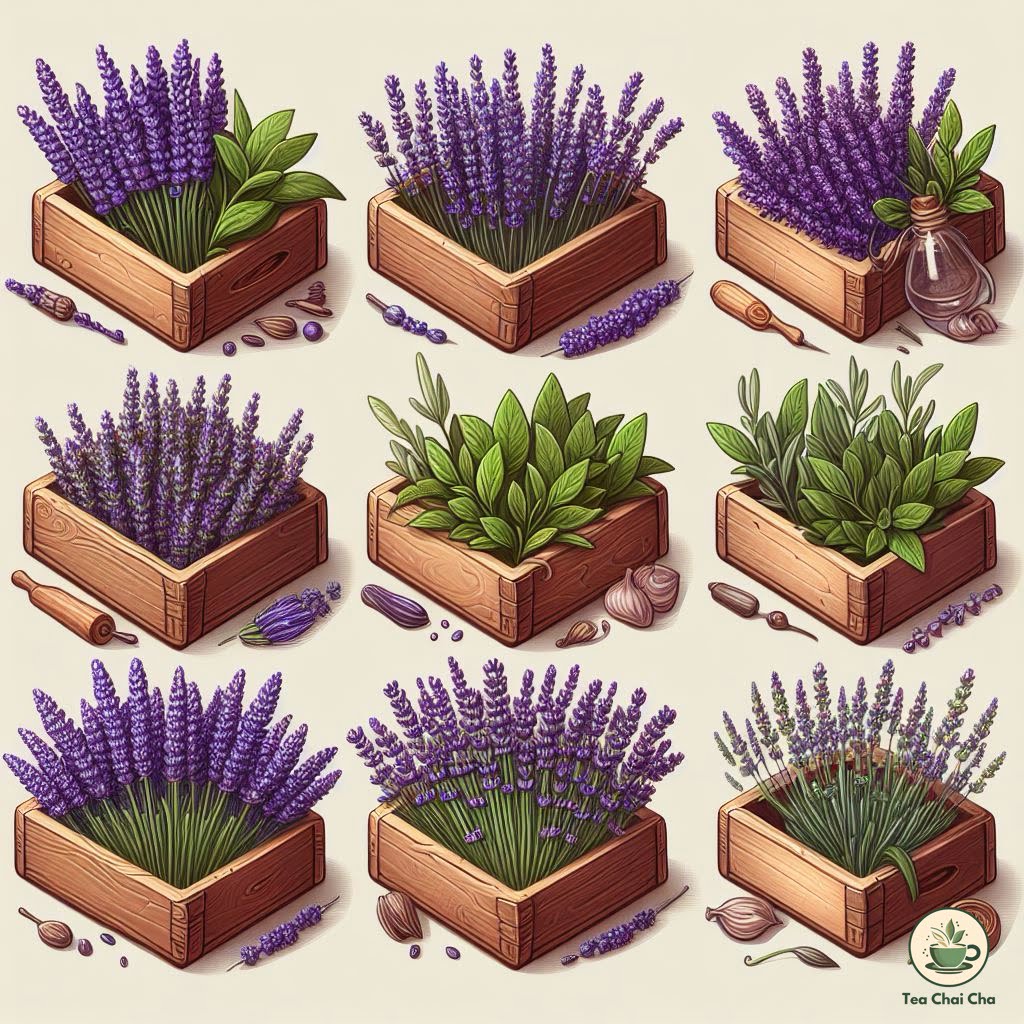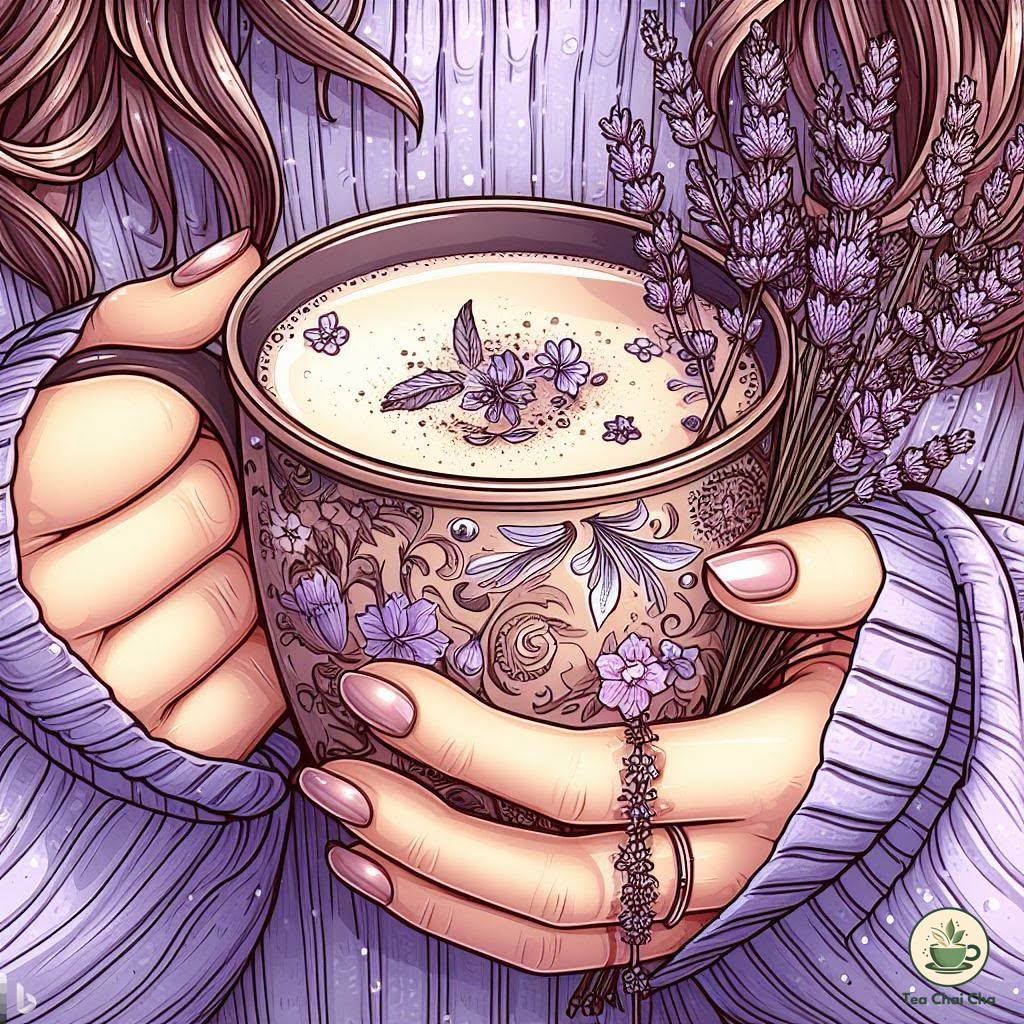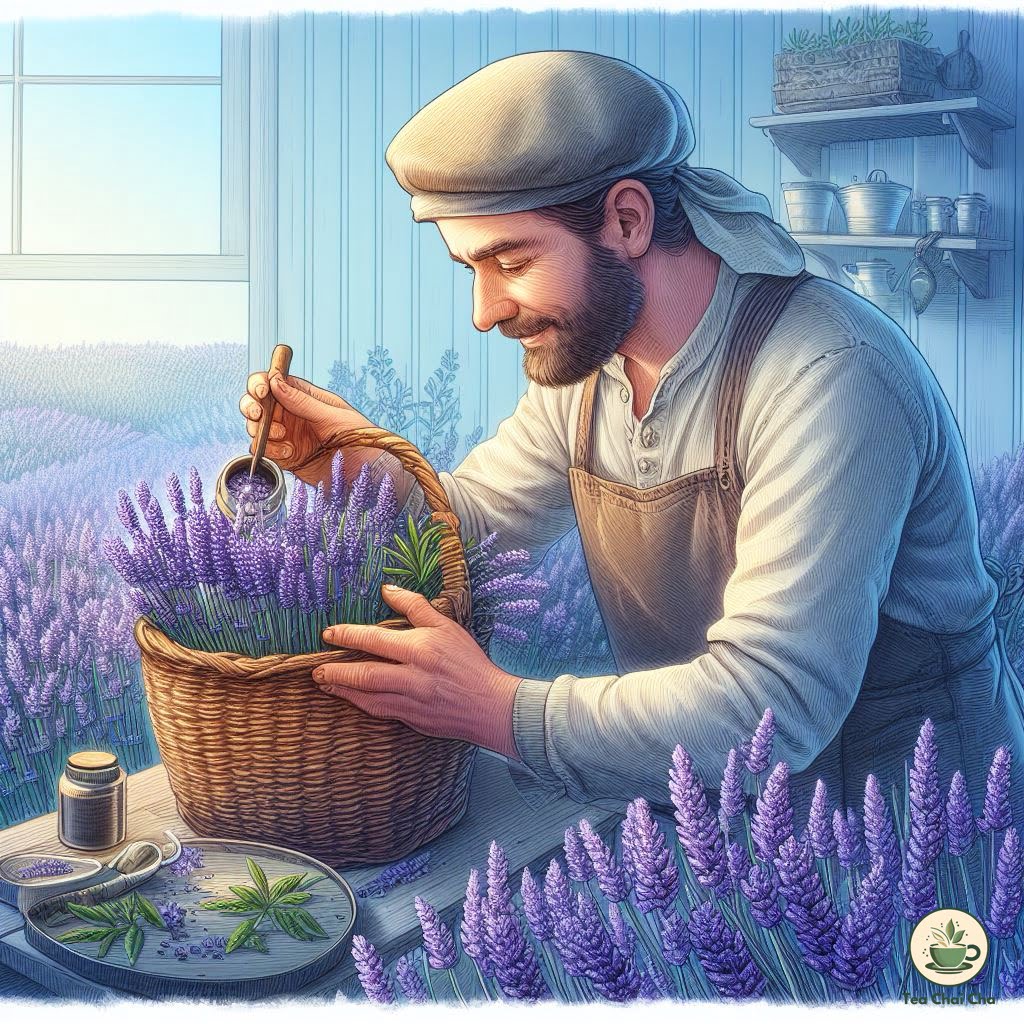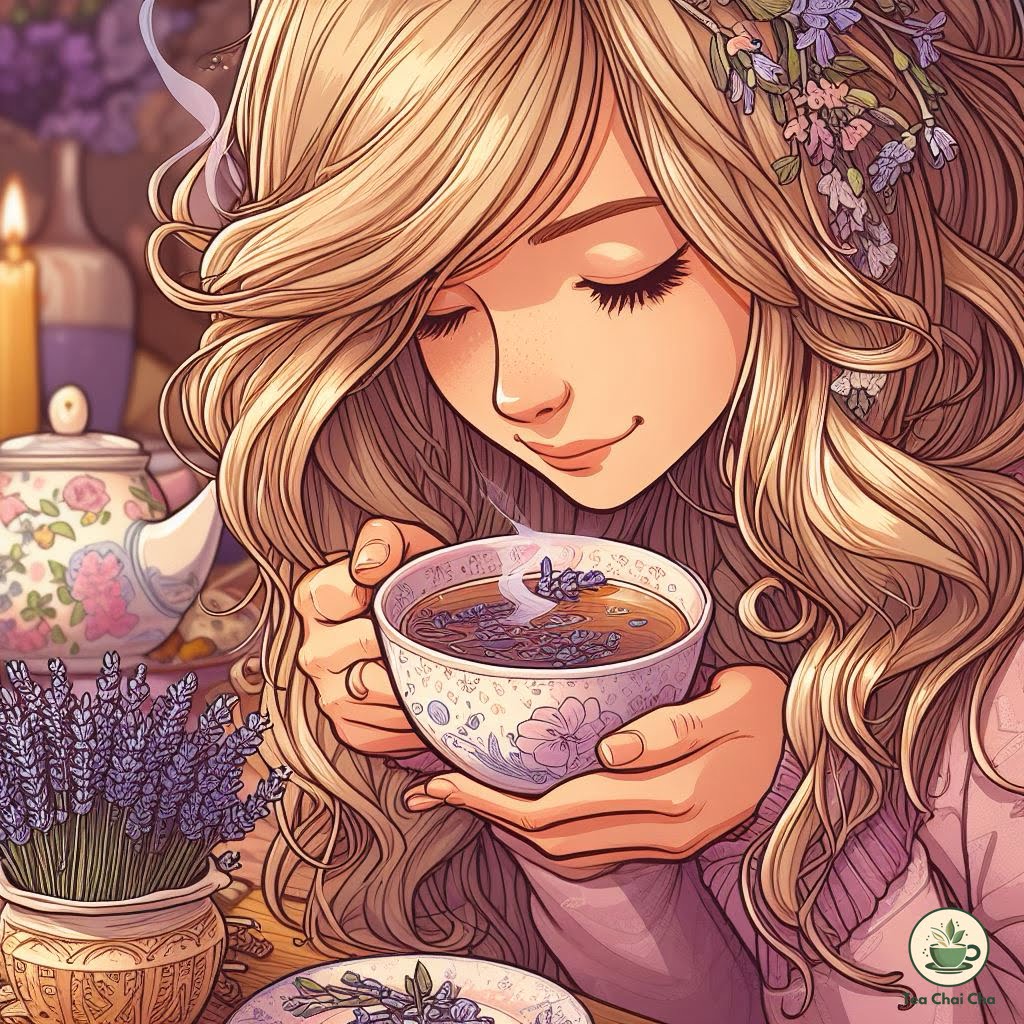Have you noticed that lavender is all the rage right now?
It’s popping up everywhere, from fancy tables to cute flower crowns, and even in drinks and sweets like lemonades and pastries.
The reason?
Lavender has a special smell that people love, so it’s used in things like soaps, bath salts, and oils for massages.
And guess what?
Lavender tea is becoming really popular too, even among folks who don’t usually drink tea.
People have been using lavender tea for a long time to make them feel better and more relaxed.
But here’s the cool part – you can enjoy the good things about lavender tea in more than one yummy way.
I’ve tried a few recipes that mix lavender buds with tea leaves and fruits, and they’re amazing.
They turn a regular cup of tea into something super fancy and soothing.
If you want to know how to make the delightful lavender tea using dried, fresh buds, or leaves, keep reading.
What Is Lavender?
Lavender is this beautiful purple plant that many love having around like me.
Its scientific name is Lavandula, and there are over 40 different species of lavender.
But the most common ones are French and English species including Lavandula angustifolia.
You can find it growing in gardens, fields, and even in some wild places.
Lavender is like a global traveler – it’s found in many countries, like France, Spain, and even in my neighbor’s backyard.
What makes lavender so special is its amazing smell.
It’s super fragrant and has this sweet, soothing scent.
If you’ve ever smelled it, you’ll know what I mean.
Lavender also has a taste, although it’s not as strong as its smell.
It’s a bit floral and slightly earthy.
Now, when it comes to using lavender, people get really creative. It’s not just for looking and smelling pretty.
Lavender is used in soaps, bath salts, and massage oils because its smell helps people relax.
And guess what? You can even make tea with it, which is awesome for boosting your mood and feeling calm.
In the kitchen, lavender adds a fancy touch to foods.
You can use it to make lavender-infused honey, cookies, or even lavender syrup for cocktails.
It’s like a secret ingredient that makes everything taste a little more special.
So, whether you’re using it for its lovely scent or adding it to your culinary adventures, lavender is a pretty cool plant to have around.

What Is Lavender Tea?
Lavender tea is a purple hued, soothing and fragrant herbal drink that you can make using lavender plant.
It’s made by steeping dried lavender buds in hot water.
When you do this, the lovely scent of camphor from lavender flowers infuses into the water, making a calming and aromatic tea.
The taste of lavender tea is a bit floral and subtle, not too strong with a minty finish.
It’s not like drinking a bouquet of flowers – just a gentle hint of lavender flavor.
People often drink lavender tea to relax and improve their mood because the smell and taste have a calming effect.
Making lavender tea is easy.
You just need hot water and some dried lavender buds.
You can find lavender buds in stores or even dry them yourself if you have lavender plants.
Steep the buds in hot water for a few minutes, and voila!
You have a delightful cup of lavender tea that can help you unwind and enjoy a peaceful moment.
4 Lavender Tea Benefits
Lavender isn’t just a pretty plant; it also offers some great health benefits that I’ve found quite interesting. Here are four of them:
1. Lavender for Relaxation
One of the most well-known benefits of lavender, especially in the form of lavender tea, is its ability to promote relaxation.
The magic ingredient here is linalool, a compound found in lavender.
It has a calming effect on the body, which can help reduce stress and anxiety.
2. Lavender Tea and Better Sleep
Because lavender has that relaxing effect, it’s also a helpful ally when it comes to getting a good night’s sleep.
Research has even shown that both smelling and drinking lavender tea can improve the quality of your sleep.
So, if you struggle with insomnia or just want a peaceful night’s rest, lavender tea before bedtime could be a great idea.
3. Lavender’s Aid for Menstrual Discomfort
Lavender’s lovely scent can do more than just relax you; it can also help reduce menstrual pain.
Scientists think that the aroma of lavender might have an impact on parts of the brain that deal with pain.
If you experience discomfort during your period, a cup of lavender tea might be a natural way to find relief.
4. Lavender’s Antioxidant Power
Lavender isn’t just about its scent and taste; it also has some health-boosting compounds.
One of these is linalool, the same compound responsible for its calming effect.
Linalool also acts as an antioxidant, which means it helps your body fight off harmful molecules and protects your cells.
Lavender Tea Side Effects
In general, lavender tea is safe to consume, but some individuals may experience skin irritation if they’ve had issues with lavender oil.
If you’ve had skin problems with lavender oil, be cautious when trying lavender tea.
Also, consider consulting your doctor for personalized advice

What You Need to Make Lavender Tea
Making lavender tea is super easy and doesn’t require a lot of fancy stuff.
Here’s a simple guide on what you’ll need to make your own soothing cup of lavender tea.
1. Fresh/Dried Lavender Buds (Lavandula angustifolia)
Lavender buds are the star of the show.
You can often find them at health food stores, online shops, or even dry your own if you have a lavender plant.
These buds are where all that lovely lavender flavor and aroma come from.
Always use culinary grade lavender to ensure it was not exposed to pesticides.
2. Hot Water
You’ll need hot water to steep the lavender buds.
Boil it up, but let it cool slightly before pouring it over the lavender to avoid scorching the delicate flavor.
3. Tea Infuser or Tea Bag (Optional)
A tea infuser or a tea bag can make the process easier.
If you’re using loose lavender buds, a tea infuser helps keep them contained while they steep.
But if you have tea bags with lavender inside, that works too!
4. Mug or Teacup
Of course, you’ll need a mug or teacup to enjoy your lavender tea once it’s ready.
Pick your favorite one and get ready to savor the calming aroma.
5. Sweetener (Optional)
If you like your tea on the sweeter side, you can add honey, sugar, or your preferred sweetener to taste.
It’s optional, but some people enjoy a touch of sweetness in their lavender tea like I do sometimes.
How to Make Lavender Tea from Fresh Lavender
If you’ve got fresh lavender on hand, making lavender tea is a wonderful way to put it to good use.
Fresh lavender has an extra burst of aroma that can make your tea even more delightful.
Here’s a simple guide on how to make lavender tea from fresh lavender:
Ingredients
- Fresh lavender sprigs (about 4-5 sprigs)
- 2 cups of water
Step 1: Gather Your Fresh Lavender
First, gather about 4-5 fresh lavender sprigs from your garden or a trusted source.
Make sure they look healthy and haven’t been exposed to pesticides or chemicals.
Step 2: Rinse the Lavender
Give the lavender sprigs a gentle rinse under cold water to remove any dirt or bugs.
Pat them dry with a clean kitchen towel.
Step 3: Prepare a Pot of Water
Take a medium-sized pot and fill it with 2 cups of fresh, cold water.
Step 4: Heat the Water
Place the pot on the stove and turn on the heat to medium-high.
Bring the water to a gentle simmer.
You don’t want it to boil vigorously; just some small bubbles are perfect.
For fresh lavender tea, it’s best to steep it at a temperature just below boiling, typically around 190°F (88°C).
Step 5: Add the Fresh Lavender
Once the water is simmering, carefully add the fresh lavender sprigs into the pot.
You should see the water starting to take on a light lavender color.
Step 6: Steep the Tea
Turn off the heat, cover the pot with a lid, and let the lavender steep in the hot water for about 5-7 minutes.
This allows the lovely lavender flavor and aroma to infuse into the water.
Step 7: Strain and Serve
Using a fine mesh strainer or tea infuser, strain the lavender tea into your teacup or teapot.
You can add a touch of honey or a slice of lemon if you like.

How to Make Lavender Tea from Dried Lavender
If you have dried lavender on hand, making lavender tea is still a breeze, and it will fill your space with a lovely fragrance.
It’s one of my favorite ways to enjoy this calming drink.
Here’s a simple step-by-step guide with ingredients and quantities to get you started.
Ingredients You’ll Need
- Dried lavender buds – 1 to 2 teaspoons per cup (adjust to taste)
- Water – 1 cup per serving
- Optional: Honey or lemon for added sweetness and flavor
Step 1: Gather Your Supplies
First, make sure you have all your ingredients and tools ready.
You’ll need dried lavender buds, clean water, a teapot or a heatproof container with a lid, a strainer, and a cup to serve your tea.
Step 2: Boil the Water
Pour the desired amount of water into your teapot or heatproof container.
For each cup of tea, you’ll need about 1 cup (8 ounces) of water.
Step 3: Add Dried Lavender Buds
Measure out 1 to 2 teaspoons of dried lavender buds for each cup of tea you plan to make.
Adjust the quantity to suit your taste – more buds for a stronger lavender flavor or fewer for a milder taste.
Step 4: Steep the Lavender
Place the dried lavender buds into the teapot or container with the hot water.
Cover it with a lid and let it steep.
Steeping time can vary, but usually, 5-7 minutes is a good starting point.
You can adjust the steeping time to make the tea stronger or milder.
Step 5: Strain and Serve
After steeping, use a strainer to pour the lavender tea into your cup, leaving behind the lavender buds.
If you prefer your tea sweetened, add a drizzle of honey or a squeeze of lemon to taste.
Scroll to the bottom to have complete recipe with ingredients and instructions.
How to Make Lavender Tea from Leaves
If you don’t have dried or fresh lavender buds but still want to enjoy lavender tea, you can make it using lavender leaves.
It’s a great alternative that can also offer some benefits.
Lavender leaves can be a bit milder in flavor compared to the buds but still provide a soothing and aromatic experience.
Benefits of Lavender Leaves
Lavender leaves, like the buds, are known for their calming properties.
Drinking lavender tea made from leaves may help reduce stress and anxiety, promote better sleep, and even soothe mild digestive discomfort.
Plus, it’s just a pleasant and relaxing drink to enjoy.
Here’s how you can make lavender tea from leaves:
Ingredients You’ll Need
- 1 tablespoon of dried lavender leaves or 2 tablespoons of fresh lavender leaves per cup of tea
- Freshly boiled water
- A teapot or a heatproof container with a lid
- A strainer or tea infuser
- Honey or lemon (optional, for added flavor)
Step 1: Boil Water
Start by boiling some water.
You’ll need about a cup of boiling water for each serving of lavender tea.
The water temperature for making lavender tea from leaves should be just below boiling, around 190-205°F (88-96°C).
Step 2: Measure Lavender Leaves
While the water is boiling, measure out your lavender leaves.
If you’re using dried leaves, 1 tablespoon per cup should be enough.
For fresh leaves, you’ll need about 2 tablespoons per cup for a stronger flavor.
Step 3: Place the Leaves in Your Teapot or Container
Put the lavender leaves into your teapot or heatproof container.
Step 4: Pour Hot Water
Once your water has reached a rolling boil, carefully pour it over the lavender leaves in the teapot.
Step 5: Steep the Tea
Cover the teapot or container with a lid and let the lavender leaves steep in the hot water for about 5-7 minutes.
This allows the leaves to release their flavor and aroma into the water.
Step 6: Strain and Serve
Using a strainer or tea infuser, pour the lavender tea into your cup, leaving the leaves behind.
You can add a bit of honey or a squeeze of lemon for some extra flavor if you like.
How to Make Lavender Tea Bags
I absolutely love lavender tea, and making my own lavender tea bags at home is such a fun and relaxing project.
You get to enjoy the soothing aroma and flavor of lavender whenever you want.
Plus, you can make extra to share with friends or give as thoughtful gifts.
Here’s a simple guide to making your own lavender tea bags.
Ingredients You’ll Need
- Dried lavender buds (about 1 to 2 teaspoons per tea bag)
- Empty tea bags or sachets (readily available at craft stores or online)
- Optional: Additional herbs like chamomile, mint, or lemon balm for added flavor
Step 1: Prepare Your Dried Lavender Buds
Start by ensuring you have high-quality dried lavender buds.
You can either purchase them from a store or harvest them from your own lavender plants if you have them.
Make sure the buds are clean and free of debris.
Step 2: Mix in Optional Herbs (if desired)
For extra flavor, you can mix in other herbs like chamomile, mint, or lemon balm with your dried lavender buds.
This is completely optional but can add interesting layers of taste to your tea.
Step 3: Fill the Empty Tea Bags
Open up the empty tea bags or sachets.
If you’re using larger sachets, you may need a bit more lavender.
Place about 1 to 2 teaspoons of dried lavender buds (and 1/2 teaspoon of any optional herbs) into each tea bag.
Step 4: Seal the Tea Bags
Carefully seal the tea bags using a heat-sealing machine or a simple iron.
If you don’t have either of these, you can also use a small piece of double-sided tape to secure the tea bags shut.
Step 5: Store Your Lavender Tea Bags
Once your lavender tea bags are sealed, store them in an airtight container away from direct sunlight.
This helps preserve their freshness and aroma.
Step 6: Enjoy Your Lavender Tea
Whenever you’re in the mood for a calming cup of lavender tea, simply steep one of your homemade tea bags in hot water for a few minutes.
Different Uses for Lavender Tea Bags
1. Relaxation: Sip on lavender tea to unwind and de-stress. It’s great for soothing nerves and promoting relaxation.
2. Sleep Aid: Drink a cup of lavender tea before bedtime to help improve the quality of your sleep.
3. Gifts: Create personalized tea blends with lavender and give them as gifts for special occasions.
4. Aromatherapy: Place a lavender tea bag in your pillowcase for a calming and fragrant night’s sleep.
5. Bath Soak: Drop a few lavender tea bags into your bath for a relaxing and aromatic soak.
Make Your Own Tea Bags (If You Don’t Have Empty Sachets)
If you don’t have empty tea sachets on hand, no worries!
You can easily make your own using coffee filters.
Here’s how:
Step 1: Cut the Coffee Filter
Start by cutting the sides off of a coffee filter so that it forms a rectangle shape.
This rectangle will become your tea sachet.
Step 2: Add Loose Leaf Tea
Place your desired amount of dried lavender buds (and any optional herbs) onto the center of the coffee filter.
Step 3: Fold Both Long Sides Inward
Take both long sides of the coffee filter and fold them towards the center, covering the tea inside.
Step 4: Fold the Filter in Half
Now, fold the coffee filter in half, making sure the tea is securely enclosed within.
Step 5: Trim the Top
Trim the top of your folded coffee filter to make it neat and even.
Step 6: Fold the Top Corners Down
Fold down the top corners of the filter to create a triangle shape at the top of your sachet.
Step 7: Attach a String
To make a handy tea bag, staple a piece of string (like a piece of twine or a cut-up tea bag string) to the top folds of your DIY tea sachet.
Make sure it’s securely attached.
The Make Your Own Zone has handy pictures of each step!

How to Make Lavender Tea with Milk
I love adding a creamy twist to my lavender tea, and making it with milk is a real treat.
Here’s how you can do it:
Ingredients
- 1 teaspoon dried lavender buds
- 1 cup water
- 1/2 cup milk (you can use dairy or non-dairy like almond or soy milk)
- 1-2 teaspoons honey (optional, for sweetness)
Step 1: Preparing the Lavender Tea
Start by heating 1 cup of water until it’s hot but not boiling.
You can use a kettle or microwave it for about 2 minutes.
Step 2: Steeping the Lavender Buds
Place 1 teaspoon of dried lavender buds into a tea infuser or a small mesh strainer.
Put the infuser or strainer into your favorite teacup.
Pour the hot water over the lavender buds in your cup.
Step 3: Letting it Steep
Let the lavender buds steep in the hot water for about 5-7 minutes.
This allows the flavors and aroma to infuse into the water.
You’ll see the water turn a lovely purple color.
Step 4: Adding Milk
While your lavender tea is steeping, heat 1/2 cup of milk in a separate saucepan or microwave it for about a minute until it’s warm but not boiling.
Step 5: Combining Tea and Milk
After the steeping time is up, carefully remove the tea infuser or strainer with the lavender buds from your cup.
Slowly pour the warm milk into your cup with the lavender-infused water.
You can adjust the amount of milk to your taste, more for creamier tea, less for a milder flavor.
Step 6: Sweetening (Optional)
If you prefer your tea on the sweeter side, add 1-2 teaspoons of honey or adjust the sweetness to your liking.
Stir until it’s well mixed.
Step 7: Sip and Enjoy
Now, all that’s left to do is sip your delightful lavender tea with milk.
It’s a perfect balance of floral and creamy flavors, creating a cozy and comforting drink.

Growing Lavender for Tea
Growing your own lavender for tea is a wonderful way to have a fresh and fragrant supply right at your fingertips.
I’ve done it myself, and it’s a rewarding experience.
Here’s a simple guide on how to grow lavender for tea:
Step 1: Choose the Right Lavender Variety
First things first, you’ll want to choose the right type of lavender.
English lavender, or Lavandula angustifolia, is the best choice for tea because it has a sweet and mellow flavor.
It’s also great for its lovely scent.
You can find English lavender plants at a local nursery or garden center.
Step 2: Find a Sunny Spot
Lavender loves the sun, so pick a sunny spot in your garden for planting.
It should get at least 6-8 hours of sunlight each day.
Well-drained soil is essential, as lavender doesn’t like wet feet.
Step 3: Prepare the Soil
Dig a hole about twice the size of the lavender plant’s root ball.
Mix some sand or gravel into the soil to improve drainage, as lavender doesn’t like soggy roots.
Step 4: Plant Your Lavender
Gently remove the lavender plant from its pot and place it in the hole.
Make sure the top of the root ball is level with the soil surface.
Space multiple lavender plants about 12-18 inches apart to give them room to grow.
Step 5: Watering
Water your lavender plant thoroughly right after planting.
After that, lavender prefers to be on the dry side, so be careful not to overwater.
Water deeply but infrequently, especially during the growing season.
Step 6: Pruning
To keep your lavender plants bushy and productive, prune them once a year, usually in early spring.
Cut back about one-third of the growth, making sure to avoid cutting into old, woody stems.
Step 7: Harvesting for Tea
Lavender is ready for harvesting when the buds have just started to open but are not fully bloomed.
This is when the flavor and aroma are at their best.
Cut the stems with scissors or shears, leaving about 3-4 inches of growth on the plant.
Step 8: Drying Lavender
To make tea, you’ll need to dry the lavender buds.
Gather the cut stems into small bundles and hang them upside down in a cool, dry place for about 7-10 days (details in the next section.)
You can also use a food dehydrator set to a low temperature.
Step 9: Storing Lavender Buds
Once dried, remove the buds from the stems and store them in an airtight container.
Keep the container in a cool, dark place to preserve the flavor and aroma.
Now you have your very own lavender plants for making delicious lavender tea whenever you like. Enjoy your homegrown lavender!
How to Dry Lavender for Tea
Drying lavender for tea is a crucial step to preserve its flavor and aroma.
Here’s a detailed guide on how to dry lavender for tea:
Step 1: Harvest at the Right Time
The first thing to do is to make sure you’re harvesting your lavender at the right time.
You want to pick the buds when they have just started to open but aren’t fully bloomed yet.
This is when they have the most flavor and fragrance.
Step 2: Gather the Stems
Carefully cut the lavender stems with scissors or shears.
Leave about 3-4 inches of stem attached to the buds.
Gather the cut stems into small bundles, about 6-8 stems per bundle.
Step 3: Tie the Bundles
Take a piece of twine or string and tie it tightly around the base of each lavender bundle.
Make sure the twine is secure to hold the stems together.
Step 4: Find a Dry, Dark Place
Now, you’ll need a cool, dry place to hang your lavender bundles.
It should also be a spot that doesn’t get direct sunlight.
An attic, basement, or a dry, dark room works well.
Hang the bundles upside down so that the essential oils flow down into the buds as they dry.
Step 5: Wait Patiently
Let the lavender bundles hang and dry for about 1-2 weeks.
During this time, the buds will lose their moisture and become ready for tea.
You’ll know they’re done when the buds feel crisp and crumble easily.
Step 6: Check for Dryness
After a couple of weeks, check one of the lavender bundles.
If the buds crumble easily, they are dry and ready for the next step.
If not, give them a bit more time to dry.
Step 7: Remove the Buds
Once your lavender buds are completely dry, gently strip the buds from the stems.
You can do this by running your fingers along the stems or by shaking them gently into a clean bowl or tray.
Step 8: Store in an Airtight Container
Store the dried lavender buds in an airtight container, like a glass jar or a ziplock bag.
Keep the container in a cool, dark place to maintain the flavor and aroma.

Lavender Tea Hot or Cold?
People enjoy lavender tea both hot and cold, and it really depends on personal preference and the occasion.
In terms of flavor profiles, hot lavender tea tends to bring out the full-bodied, floral notes of lavender, making it richer and more aromatic.
Cold lavender tea, on the other hand, offers a milder lavender flavor, making it a bit more refreshing and easier to sip on a hot day.
How to Make Lavender Iced Tea
I absolutely love sipping on lavender iced tea, especially on a hot day.
It’s a wonderful way to enjoy the calming essence of lavender while staying cool.
There are two great methods to make it: the cold brew method and the iced tea method.
Let’s check both.
Cold Brew Lavender Iced Tea
Ingredients
- 2 tablespoons of dried lavender buds
- 4 cups of cold water
- 2-3 teaspoons of honey (optional)
- Ice cubes
- Lemon slices (optional, for garnish)
Step 1: In a large pitcher, combine the dried lavender buds and cold water. Stir it gently to make sure the lavender is fully submerged.
Step 2: Put the pitcher in the fridge and let it steep for at least 6-8 hours, or overnight for the best flavor.
Step 3: After steeping, strain out the lavender buds from the tea using a fine-mesh strainer or cheesecloth. You’ll be left with lavender-infused water.
Step 4: If you like your tea sweet, you can add honey to taste while it’s still cold. Stir until the honey is dissolved.
Step 5: Serve your cold brew lavender tea over ice cubes, and garnish with lemon slices if you like. Enjoy the cool and relaxing flavors!
Iced Lavender Tea
Ingredients
- 2 tablespoons of dried lavender buds
- 2 cups of boiling water
- 2 cups of cold water
- 2-3 teaspoons of honey (optional)
- Ice cubes
- Lemon slices (optional, for garnish)
Step 1: In a heatproof pitcher, add the dried lavender buds.
Step 2: Pour the boiling water over the lavender buds and let it steep for about 5-7 minutes. This is like making a strong lavender infusion.
Step 3: After steeping, strain out the lavender buds using a fine-mesh strainer or cheesecloth.
Step 4: Add the cold water to the lavender infusion and stir.
Step 5: If you want some sweetness, add honey to taste and stir until it’s well mixed.
Step 6: Fill glasses with ice cubes and pour the lavender iced tea over them.
Step 7: Garnish with lemon slices if you wish, and enjoy the refreshing lavender goodness!
4 Factors That Affect the Flavor of Lavender Tea
When it comes to enjoying a cup of lavender tea, the flavor can vary based on a few important factors.
Here, I’ll share my experience and insights into what affects the flavor of lavender tea.
1. Lavender Variety (Species)
Different lavender species can have slightly different flavor profiles.
For example, Lavandula angustifolia, also known as English lavender, is often preferred for tea due to its sweet and mellow flavor.
On the other hand, Lavandula stoechas, or Spanish lavender, can have a more robust and pungent taste.
So, the type of lavender you use will definitely influence the flavor of your tea.
2. Lavender Freshness and Quality
The quality and freshness of the lavender buds are crucial.
Using dried lavender buds that are too old can result in a weaker flavor, while fresh, high-quality buds will give your tea a more vibrant and aromatic taste.
I recommend sourcing only culinary-grade lavender from reputable suppliers to ensure the best flavor.
3. Brewing Time and Temperature
The way you brew your lavender tea matters a lot.
Steeping the buds for too long or using water that’s too hot can lead to a stronger, sometimes bitter taste.
Generally, steeping for 5-7 minutes in water just below boiling (around 190-205°F or 88-96°C) works well for a balanced lavender tea flavor.
4. Proportions of Lavender Buds
Finding the right balance between lavender buds and other tea leaves or herbs is essential.
Too much lavender can make the tea taste overpoweringly floral, while too little may result in a weak lavender flavor.
Using 1-2 teaspoons of dried lavender is a good start.
Experiment with different proportions to find what suits your taste best.

How to Make Lavender Tea Taste Better
If you’ve tried lavender tea and found its taste a bit too subtle or floral for your liking, don’t worry.
There are some easy ways to make lavender tea taste better.
I’ve experimented with different ingredients and methods, here’s what you, too, should know.
1. Sweeten it Up with Honey or Sugar
Adding a touch of sweetness can make a world of difference.
Try stirring in a spoonful of honey or sugar to your cup of lavender tea.
It balances out the floral notes and adds a pleasant sweetness that many people enjoy.
You can even try different fruits syrups or maple syrup.
2. Blend with Black or Green Tea
Lavender tea on its own can be quite delicate.
Mixing it with a black or green tea can give your cup a more robust flavor.
I like to combine one part lavender tea with one part black or green tea leaves before steeping.
This creates a harmonious blend that’s flavorful and aromatic.
3. Citrus Zest for Zing
A squeeze of lemon or a twist of orange peel can brighten up your lavender tea.
The citrus zest adds a refreshing and tangy element that pairs wonderfully with the lavender’s floral notes.
Just drop a small piece into your tea and let the flavors mingle.
4. Fresh Herbs for Depth
Experimenting with fresh herbs is another great option.
A sprig of mint or a few basil leaves can complement lavender beautifully.
It adds depth to the taste and a hint of herbal freshness.
5. Try Lavender Tea Blends
If you’re not a fan of lavender’s taste on its own, consider purchasing pre-blended teas that incorporate lavender with other flavors like chamomile or mint.
These blends are expertly crafted to provide a balanced and enjoyable taste.
Related – How to Make Tea Taste Better in 10 Ways!

Lavender Tea Food Pairing
Lavender’s gentle, floral notes can complement various dishes and treats, making it even more enjoyable.
Here are some of my favorite food pairings to create a delightful culinary adventure with lavender tea.
Lavender Tea and Desserts
Lavender tea is like a dessert itself, but when you pair it with sweet treats, it’s pure magic.
I’ve found that lavender tea goes wonderfully with:
1. Lavender Shortbread Cookies
These cookies goes well with lavender tea.
The buttery, crumbly texture of shortbread perfectly balances the floral notes of the tea.
It’s a delightful combination for a cozy afternoon snack.
2. Lemon Lavender Cupcakes
The zesty lemon and aromatic lavender in these cupcakes create a fantastic flavor duo with lavender tea.
The citrusy tang of the cupcakes complements the tea’s soothing qualities.
Lavender Tea and Savory Dishes
Don’t just limit lavender tea to sweets; it can work wonders with savory dishes too.
I’ve enjoyed it with:
1. Lavender-Infused Chicken
Marinating chicken with lavender and herbs adds a unique, fragrant twist to your meal.
It’s a savory delight that pairs beautifully with a cup of lavender tea.
2. Lavender and Goat Cheese Tart
A lavender-infused goat cheese tart is a savory treat that perfectly complements the tea’s floral notes.
It’s a sophisticated pairing that’s sure to impress your taste buds.
Lavender Tea and Light Snacks
For a simple, light snack, consider pairing lavender tea with:
1. Lavender-Infused Honey on Toast
Spread some lavender-infused honey on warm toast for a quick and delightful snack.
The hint of lavender adds a unique twist to a classic treat.
2. Lavender Tea and Fresh Fruit
A fruit salad featuring fresh berries and a drizzle of lavender-infused syrup is a refreshing and healthy choice.
The fruity flavors harmonize wonderfully with the floral notes of lavender tea.

When to Drink Lavender Tea
Lavender tea is best enjoyed when:
- Feeling Stressed or Anxious: It helps calm your nerves and reduce stress.
- Before Bedtime: Enhances sleep quality and serves as a soothing bedtime ritual.
- After a Long Day: Perfect for unwinding after a tiring day.
- Need a Mood Boost: Lifts your spirits with its pleasant aroma.
- During Meditation or Yoga: Creates a serene atmosphere for mindfulness practices.
In short, lavender tea can be a comforting and mood-enhancing addition to various moments in your day.
Related to Tea Brewing

Lavender Tea Recipe
Recipe by Tania FaysalCourse: DrinksCuisine: Other world cuisine2
servings5
minutes10
minutes15
kcal15
minutesUnwind with this soothing Lavender Tea Recipe – serves 2, perfect for a calming evening!
Ingredients
2 cups of water
2 tablespoons of dried lavender flowers
2 teaspoons of honey (optional)
2 lemon slices (optional)
Directions
- Heat the water: In a medium-sized pot, bring 2 cups of water to a boil.
- Add lavender: Once boiling, add 2 tablespoons of dried lavender flowers.
- Lower the heat: Reduce the temperature to low and let the lavender steep for 10 minutes. The ideal steeping temperature is 190-205°F (88-96°C). You don't want the water to be boiling.
- Strain the tea: Use a fine mesh strainer to remove the lavender flowers, pouring the liquid into your favourite teacups.
- Sweeten your tea: If desired, add a teaspoon of honey to each cup for a touch of natural sweetness.
- Serve with lemon: Enhance the flavor with a slice of lemon in each cup, if you wish.
Recipe Video
Notes
- Alternatives: If you don't have dried lavender flowers, you can use fresh lavender buds from your garden, as long as they haven't been treated with pesticides. You can also experiment by combining lavender with other herbs like chamomile, mint, or rosemary for unique flavors.
- Storing Lavender Tea: To keep your dried lavender fresh and fragrant, store it in an airtight container away from direct sunlight and moisture. This will maintain its flavor and aroma for future tea-making.
- Steeping Time: Be mindful not to over-steep the tea, as this can make it bitter. 10 minutes is generally the right amount of time for lavender tea to steep and infuse its delightful flavor.
- Cool it Down: Allow the brewed tea to cool to room temperature naturally. Do not leave it out for too long, as leaving it at room temperature for more than 2 hours can promote bacterial growth.
- Store in the Refrigerator: Place the sealed container in the refrigerator. Brewed lavender tea can be stored in the fridge for up to 3-4 days.
- Tea Cubes: If you want to make iced tea, its better to freeze brewed lavender tea in ice cube tray. This way your tea won't be diluted when using ice.
Frequently Asked Questions (FAQs)
What does lavender tea taste like?
Lavender tea has a gentle, floral flavor with subtle herbal (minty) notes. It’s not overpowering, providing a soothing and aromatic taste that many find calming and pleasant.
Does lavender tea have caffeine?
No, lavender tea is naturally caffeine-free. It’s an herbal infusion made from lavender buds, not from tea leaves, which typically contain caffeine.
Is lavender a real tea?
Lavender tea is not a “real” tea because it doesn’t come from the Camellia sinensis plant, which is the source of traditional teas like black, green, or white tea.
Instead, it’s an herbal tea or tisane made from dried lavender buds.
How many calories are in lavender tea?
Lavender tea is extremely low in calories.
A typical cup of lavender tea contains only a few calories, primarily from any sweeteners or additives you might choose to include.
What is the lavender tea recipe for sleep?
To make lavender tea for better sleep, you can follow the recipe I shared earlier.
Besides, you can get creative by mixing lavender with other herbs known for their calming effects such as chamomile.
